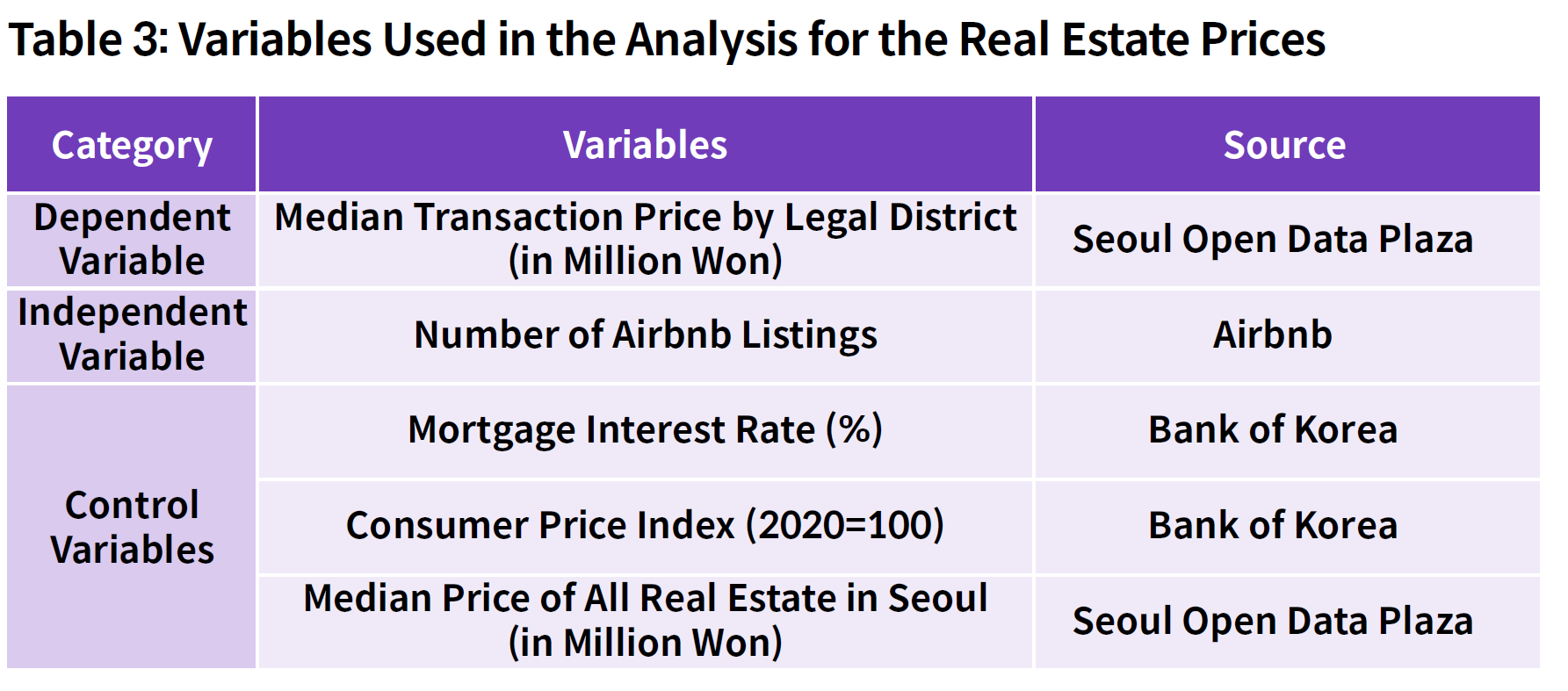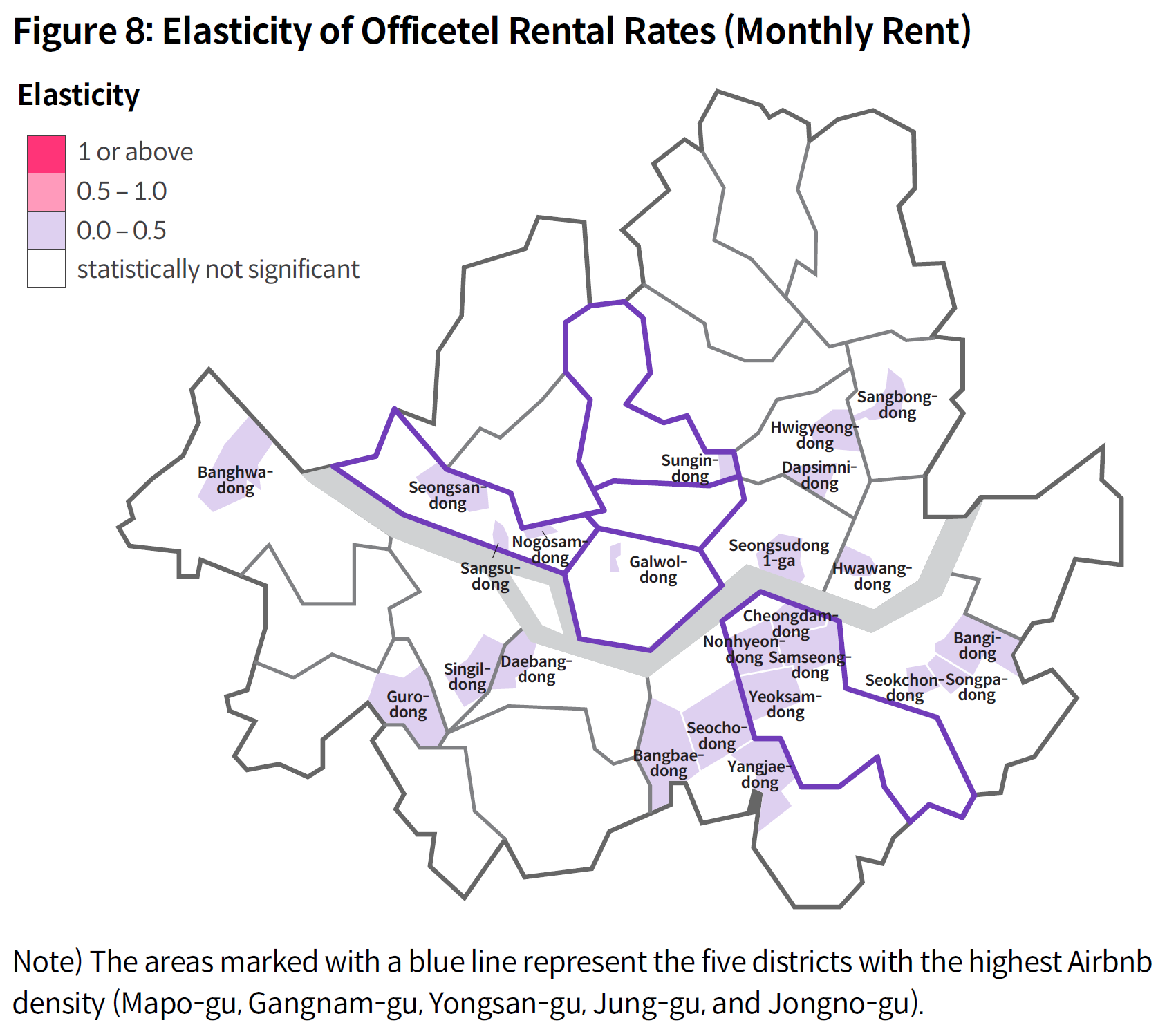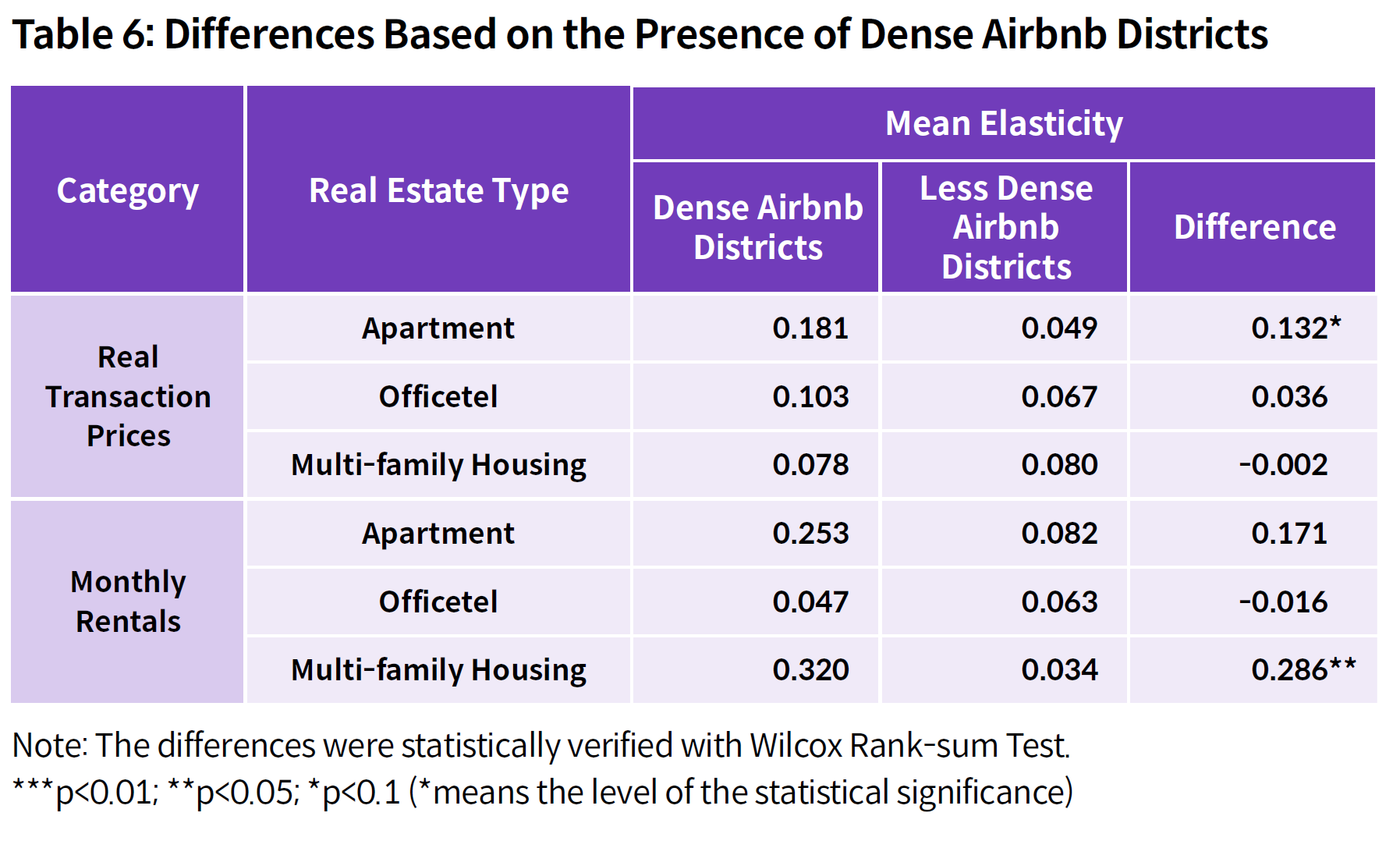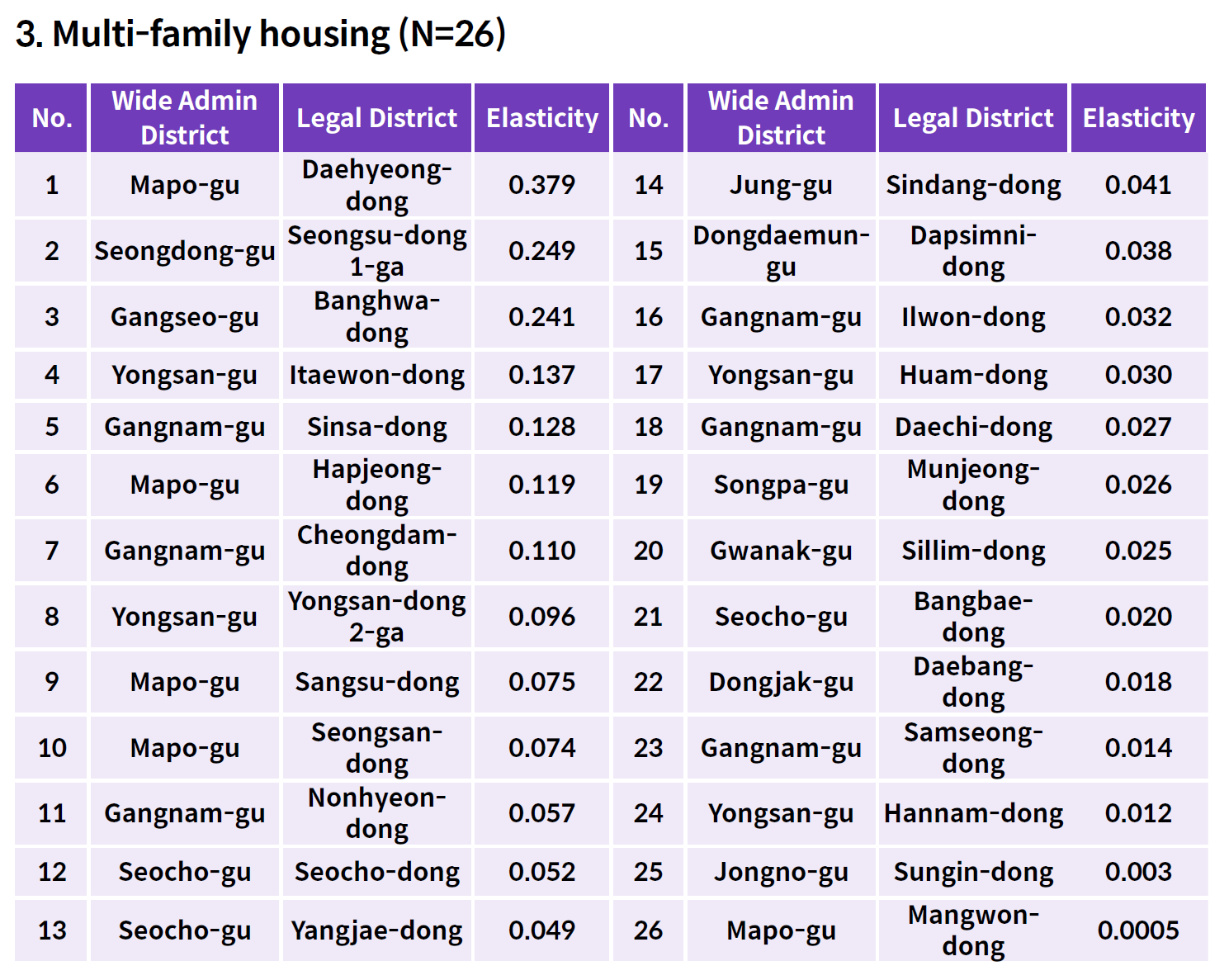Airbnb's Growth and Its Impact on the Seoul Real Estate Market
SooCheong Jang, Ph.D. Professor, Purdue University / Director, CHRIBA, Purdue University / [email protected]
Dohyung Bang, Doctoral Student, Purdue University / Researcher, CHRIBA, Purdue University / [email protected]
1.Research background and the objectives
1.1. The Home-Sharing Industry and Its Impact on the Real Estate Market
According to a 2022 Vantage Market Research report, the global home-sharing market was valued at $100.8 billion and is projected to reach $228.9 billion by 2030. This indicates that home-sharing has become a significant sector in the hospitality industry with substantial potential for continued growth. Generally, an increase in accommodation supply signifies a boost in the tourism industry, which can lead to the revitalization of local economies.
However, the growth of the home-sharing industry has also highlighted several issues. As a result, major cities around the world are tightening regulations on home-sharing. The rise of platforms like Airbnb has significantly increased the supply of accommodations, but this is perceived as contributing to overtourism and negatively impacting local communities in cities where large-scale real estate investments and developments have already been made. Additionally, there are concerns about the increase in social costs in major cities due to the negative impacts of home-sharing.
A prime example of these issues is seen in Venice, Italy. According to Inside Airbnb, as of June 2023, about 7,000 Airbnb listings are concentrated in Venice's main tourist areas. This signifies a shift from spaces that were once residential housing for locals to accommodations for tourists. This has led to a significant decrease in housing availability, potentially threatening the housing rights of local residents and the stability of the community in the long term.
* Short-term Rental and Home-Sharing
Short-term rentals and home-sharing are similar concepts, but they differ in that short-term rentals often involve professional real estate companies or investors operating entire apartments or multiple lodging facilities, representing a more organized form of rental business compared to home-sharing. In many countries, individual hosts offer personal homes as lodging, but accommodations provided by professional real estate companies are also commonly available through platforms. For this reason, alternative accommodation services like Airbnb are categorized as short-term rental businesses rather than merely home-sharing. In South Korea, under Article 2, Section 1, Item 2 of the Public Health Control Act, "businesses providing facilities and services where guests can sleep and stay" are defined as lodging businesses. Short-term rental businesses using properties not originally intended for accommodation, like Airbnb, must register as urban guesthouses under the Tourism Promotion Act. Consequently, in Korea, regardless of the business entity, the term 'lodging business' is more commonly used than 'rental business'. Therefore, to facilitate understanding among Korean readers, the term 'home-sharing business' is used in this study to refer to what is known internationally as the short-term rental business.
* Apartments in South Korea Apartments are similar to condominiums in the United States in that individuals own their respective units within a building.

Other cities in Europe and the United States are experiencing similar situations, and the issue extends beyond just housing availability. The sharp imbalance between housing demand and supply is leading to increases in property prices and rent. In New York City, the rise in home-sharing supply due to Airbnb is causing a decrease in long-term rental housing supply, leading to higher living costs. A 2018 report by the New York City Comptroller's Office showed that the increase in Airbnb had a significant impact on rent increases in various areas. Notably, areas like 'Murray Hill, Gramercy & Stuyvesant Town' and 'Chelsea, Clinton & Midtown Business District' saw rent increases of over 20%, which is clear evidence of these changes.
Therefore, while the rapid growth of the home-sharing industry can have positive effects on the tourism industry and local economies, the negative impacts on the housing market and local communities cannot be ignored. This suggests that policymakers need to give more careful consideration to the regulation and management of the home-sharing industry.

1.2. Strengthening of Home-Sharing Industry Regulations in Major Cities Worldwide
Despite the economic benefits brought by home-sharing platforms, major cities around the world are establishing regulations to minimize social issues. New York City enacted the 'Short-Term Rental Registration Law' (or 'New York City Local Law 18') in 2022 and started implementing it in September 2023. Los Angeles had already established the 'Home-Sharing Ordinance' (HSO) in 2018. The key provisions of these laws require hosts to register with the city government to operate home-sharing businesses and set annual limits on the duration for which a housing unit can be converted into a home-sharing accommodation. The primary goal is to regulate home-sharing within legal frameworks, preventing excessive conversion of residential units into homesharing accommodations and thus minimizing the negative impact of homesharing expansion on housing availability and housing costs.

According to a study by Koster et al. (2018), the real estate rental prices in LA County significantly decreased after the enactment of HSO in 2018, demonstrating the effectiveness of regulations in stabilizing the real estate market.
1.3. The Extent of Airbnb's Impact on Property Prices and Rental Rates in Seoul?
In Seoul, compared to European cities with high tourism dependency or major cities in the United States, the density of Airbnb accommodations is generally not high. As of March 2023, there are about 44,000 Airbnb listings in New York City and about 77,000 in London, while Seoul has relatively fewer, with approximately 14,000. However, there are areas in Seoul where Airbnb accommodations are concentrated, and the increase in the number of these accommodations, considering the overheating of the Seoul real estate market, can have a significant impact even with fewer numbers.
Moreover, in South Korea, shared accommodation businesses are regulated as 'urban guesthouses' under the Tourism Promotion Act, but most accommodations are essentially in a regulatory blind spot. Therefore, while there is movement towards strengthening regulations on shared accommodation businesses, a clear understanding of the potential consequences of the growth of these businesses on the accommodation industry and local communities is needed before taking proactive measures. The experiences of major cities abroad suggest that the growth of shared accommodations can significantly impact the real estate market. Based on this background, this study aims to:

2. Growth of Airbnb in Seoul and Trends in Property Prices and Rental Rates
As of April 2023, there are a total of 13,945 Airbnb listings registered in Seoul. Looking at Figure 2, Airbnb accommodations are registered throughout Seoul, but it can be seen that some areas have a high density of accommodations. Particularly, as of April 2023, over 8,000 Airbnb listings are concentrated in just five districts: Mapo-gu, Gangnam-gu, Yongsan-gu, Jung-gu, and Jongno-gu, with Mapo-gu alone accounting for more than 2,900 of these listings.

Among the 467 legal districts in Seoul, the top 10 areas with the highest number of Airbnb listings are shown in Table 2. It can be observed that these top legal districts are generally concentrated in certain areas. Notably, Seogyodong has 628 registered accommodations. Considering that these properties were previously used as residences, this indicates a corresponding decrease in the number of available real estate products for residency in the area. Thus, the increase in the number of Airbnb listings suggests that it could impact the real estate market in certain areas.

Figure 3 shows the trends in changes in property prices and rental rates by type of real estate in Seoul, as well as the change in the number of Airbnb listings. First, examining the trend of real estate prices and the increase in Airbnb listings (a) in Figure 3, the price fluctuations of officetels and multifamily housing are relatively small, while the price changes of apartments have shown high volatility since 2017. Notably, this period coincides with a rapid increase in Airbnb listings and rising trends in real estate prices, suggesting a need to statistically ascertain if there is a significant correlation between the increase in Airbnb listings and real estate price fluctuations.
Meanwhile, looking at the trend of real estate rental rates and the increase in Airbnb listings (b) in Figure 3, the fluctuation in rental rates for officetels and multi-family housing is relatively minor, but the changes in apartment rental rates are more pronounced. Particularly for apartment rentals, until 2017, they generally maintained a consistent level, showing a temporary rise each January. However, since 2017, the pattern has become irregular with fluctuations, and since 2020, there has been a general upward trend. The monthly rental rates for officetels and multi-family housing have also shown a steady increase since 2020. These trends, coinciding with the increasing trend of Airbnb listings, indicate the need to empirically verify the relationship between the increase in Airbnb listings and real estate rental rates.

3. Methodology
3.1. Data and variables
This study analyzed data collected monthly by legal district (‘Dong’) in Seoul to clarify the relationship between the real estate market in Seoul and the growth of Airbnb. Out of 467 legal districts in Seoul, 94 districts with 30 or more Airbnb listings registered as of December 2022 were selected for analysis. The data used in this study and their sources are listed in Tables 3 and 4, respectively. According to Table 3, to examine the impact on Seoul real estate prices, the median transaction value of real estate in Seoul's legal districts per month was chosen as the dependent variable, and the cumulative number of Airbnb listings was selected as the independent variable. To control for exogenous factors, the mortgage interest rate, consumer price index, and median price of all real estate in Seoul were used as control variables. The data for this analysis comprised monthly data from January 2010 to December 2022.

According to Table 4, to analyze the impact of Airbnb expansion on monthly rental rates in Seoul, the median monthly rent of each legal district was chosen as the dependent variable. In this study, monthly rent includes both jeonse and monthly rent deposits converted into monthly rental rates. The conversion of monthly rent was conducted using the monthly lease conversion rate by district. Similar to the real transaction price model, the cumulative number of Airbnb listings was selected as the independent variable, and the jeonse loan interest rate, consumer price index, and median monthly rent of all Seoul were used as control variables. The data were collected monthly, but due to constraints in data utilization, the model verifying the impact on lease rates, unlike the real transaction price model, comprised data from January 2011 to December 2022.

3.2. Analysis Model
This study aims to elucidate the impact of Airbnb's expansion on real estate prices and rental rates by statistically verifying the causal relationshipsbetween monthly time series data for each legal d istrict. Since the main variables, real estate prices, rental rates, and the number of Airbnb listings, show an increasing trend over time, using a standard regression model could lead to spurious causality. Therefore, this study selected the Vector Error Correction Model (VECM), a econometric model advantageous for estimating causal relationships in time series, as the empirical model.
VECM is an appropriate model that explains short-term impact relationships between variables using autoregressive terms while describing the long-term equilibrium between variables through error correction terms. This study aims to estimate the long-term elasticity between the increase in Airbnb listings and real estate prices and rental rates using VECM. Elasticity measures the rate of change in real estate prices and rental rates due to a 1% increase in Airbnb listings and is a suitable indicator to quantify the effect of Airbnb on the real estate market.

4. Analysis Results
4.1. The Impact of Airbnb on the Increase of Real Estate Prices in Seoul
Figure 4 shows the 28 legal districts where long-term elasticity of apartment real transaction prices is significantly evident due to the expansion of Airbnb. According to the analysis, there is a relative concentration of significant legal districts in Mapo-gu and Gangnam-gu, where the density of Airbnb is the highest overall. However, numerous legal districts outside these high-density Airbnb areas also showed significant elasticity, suggesting that the effects of Airbnb can be determined by the unique characteristics of each legal district, independent of Airbnb density. Among the 28 legal districts with significant elasticity, only "Hannam-dong" shows an elasticity of more than 1, while the rest have elasticity of 0.5 or less. This indicates that if the number of Airbnb listings increases by 1%, the apartment prices in Hannam-dong are expected to rise by more than 1%.

Figure 5 shows the results for 20 legal districts where the impact of Airbnb on the real transaction prices of officetels is significantly evident. Among the five districts with high Airbnb density, only Gangnam-gu shows pronounced elasticity in real transaction prices due to Airbnb expansion. In other high-density districts, the Airbnb effect is not as clear. Instead, significant elasticity is observed in some legal districts not belonging to the high-density Airbnb districts, which are known for a high supply of officetels (e.g., Seocho-dong, Bangbae-dong, Jamsil-dong, Guro-dong, Bongcheon-dong, etc.).

Figure 6 presents the results of verifying the impact of Airbnb on the real transaction prices of multi-family housing. For these types of real estate, legal districts with significant long-term elasticity in real transaction prices are mostly located in districts with high Airbnb density. Additionally, the areas where elasticity is significant tend to be regions with a high concentration of multi-family housing (e.g., Mangwon-dong, Hapjeong-dong, Dabang-dong, Sillim-dong, Huam-dong, Itaewon-dong, etc.). This suggests that the impact of Airbnb on price increases in multi-family housing may be more pronounced in areas with concentrated Airbnb expansion.
Meanwhile, all legal districts where elasticity of real transaction prices is significant for each type of real estate can be found in Appendix 1.

4.2. The Impact of Airbnb on Rental Rates in Seoul Real Estate
Figure 7 shows the 22 legal districts where the elasticity of monthly apartment rental rates is significantly evident due to the expansion of Airbnb. In Mapogu, the district with the highest Airbnb density, significant results were found in 5 legal districts, among which "Hapjeong-dong" showed relatively high elasticity, indicating that the impact of Airbnb on real estate rental rates is pronounced in Mapo-gu. Notably, despite a relatively low proportion of apartments, significant Airbnb effects were observed in "Bongcheondong" and "Sillim-dong," which have high Airbnb densities. Among the 22 legal districts with significant elasticity in monthly apartment rental rates, "Hoehyeon-dong 1-ga" was the only one to exhibit an elasticity exceeding 1.

Figure 8 displays the legal districts where the elasticity of monthly officetel rental rates is significantly evident due to the expansion of Airbnb. The elasticity of officetel rental rates is particularly pronounced in the Gangnam districts, including Gangnam-gu, Seocho-gu, and Songpa-gu. Of the 24 legal districts that showed significant elasticity, 10 belong to these three districts. These areas not only have a high proportion of Airbnb listings but are also known for their high concentration of officetels. Additionally, regardless of the district, some legal districts with a high concentration of officetels (e.g., Banghwa-dong, Singil-dong, Seongsu-dong 1-ga, Hwayang-dong) showed significant effects of Airbnb listing increases on rental rate rises.

Figure 9 shows the legal districts where the elasticity of monthly rent for multi-family housing is significantly evident due to the expansion of Airbnb. Among the 27 legal districts with significant elasticity, the Airbnb effect is most pronounced in the Mapo-gu area, where both the density of Airbnb and multi-family housing are high. Particularly in “Sangsu-dong” of Mapo-gu, the elasticity of real estate rental rates exceeds 1. It is also noteworthy that significant Airbnb effects are observed in some legal districts with high multifamily housing density among those with a high number of Airbnb listings (e.g., Changcheon-dong, Sillim-dong). Additionally, significant Airbnb effects were observed in some legal districts where multi-family housing is relatively concentrated in Seoul, despite a lower density of Airbnb listings.
All legal districts with significant elasticity in rental rates for each type of real estate can be found in Appendix 2.

4.3. Analysis of Differences According to the Characteristics of Each Legal District
The previous government announced dozens of real estate measures to stabilize Seoul's real estate market. Among these, the so-called '8.2 measures' announced on August 2, 2017, and the real estate measures of August 27, 2018, designated 15 districts in Seoul as 'speculative areas.' Since shared accommodation businesses like Airbnb can contribute to fluctuations in real estate market supply and demand, it is crucial to understand the relationship between real estate policies during periods of speculative overheating and the expansion of Airbnb.
Therefore, this study additionally verified how the effects of Airbnb differ between speculative and non-speculative areas by analyzing the elasticity differences. According to the difference analysis results in Table 5, for 'apartments', there were significant differences in both real estate prices and rental rates depending on whether the area was designated as speculative. For 'officetels', there was a significant difference in real estate prices, but no difference in rental rates. On the other hand, 'multi family housing' showed no significant difference in real estate prices but did show a significant difference in rental rates.

Table 6 presents the results of the analysis comparing differences between the five dense Airbnb districts in Seoul (Mapo-gu, Gangnam-gu, Yongsan-gu, Jung-gu, and Jongno-gu), where over 1,000 Airbnb listings are registered, and the less dense districts. According to the analysis, for 'apartments', significant differences were found only in real estate prices. For 'officetels', there were no significant differences in either real estate prices or rental rates. On the other hand, for 'multi-family housing', no difference was found in real estate prices, but there was a significant difference in rental rates.

5. Results
5.1. Key Findings
This study analyzed the effect of Airbnb across three types of real estate in Seoul's legal districts using two dependent variables (real transaction price and rental rate), dividing the analysis into six cases (three types of real estate × two dependent variables). Of the legal districts, 11 showed significant results in four or more cases, as listed in Table 6. Among these, 'Sangsu-dong', 'Samseong-dong', 'Guro-dong', and 'Bangbae-dong' showed significant results in five of the six cases, and 'Seocho-dong', 'Cheongdam-dong', 'Yangjae-dong', 'Dapsimni-dong', 'Hwayang-dong', 'Munjeong-dong', and 'Seongsan-dong' in four cases. Notably, 10 out of these 11 districts showed significant Airbnb impact on officetel rental rates. In other words, these 11 legal districts can be interpreted as the most affected by Airbnb's expansion in terms of real estate prices and rental rates in Seoul.
To summarize the findings, the effect of Airbnb on apartment real transaction prices was prominent in legal districts of Mapo-gu and Gangnam-gu. The impact of Airbnb on officetel real transaction prices was significant in districts known for a high supply of officetels. In terms of multi-family housing real transaction prices, the effect was most notable in Mapo-gu, Yongsan-gu, and Gangnam-gu areas.
Regarding rental rates, the impact of Airbnb on apartment rental rates was significant in Mapo-gu's legal districts. The effect on officetel rental rates was particularly evident in legal districts located in the three Gangnam districts (Gangnam-gu, Seocho-gu, Songpa-gu). Similar to real transaction prices, the impact of Airbnb on multi-family housing rental rates was especially noticeable in Mapo-gu, where both Airbnb and multi-family housing densities are high.
The impact of Airbnb on multi-family housing can also be observed in the difference analysis by legal district. While the elasticity of multi-family housing prices showed no difference based on speculative area designation or Airbnb density, a significant difference was found in rental rates. This implies that the expansion of Airbnb could affect the rise in rental rates for residents of multifamily housing, particularly in speculative risk areas or areas with high Airbnb density. Mapo-gu is a typical example of this phenomenon.
Overall, the study confirms that the increase in Airbnb has influenced the rise in real estate prices and rental rates in certain areas of Seoul. However, this impact was not consistent across Seoul and varied by legal district. It's noteworthy that Airbnb's effect on the real estate market is significant not only in areas with high Airbnb density but also in less dense areas, particularly in some non-central regions where real estate fluctuations are relatively less.

5.2. Implications and conclusion
This study finds significance in its analysis of the impact of Airbnb on Seoul's real estate market, particularly on property prices and rental rates, differentiated by legal district and property type. It revealed that while Airbnb's growth does not uniformly affect all areas of Seoul, it does influence property price increases in some regions. Specifically, it uncovered heightened sensitivity in real estate prices in areas with high speculation risk.
Moreover, the study provides critical insights into the impact of Airbnb's expansion on residential costs, i.e., real estate rental rates. Notably, the fact that Airbnb significantly contributes to rental rate increases in areas dense with multi-family housing, like Mapo-gu, suggests Airbnb's growth could exacerbate housing burdens for the general populace. This underscores the need for close monitoring and response to Airbnb's ongoing growth and its effects on housing availability and costs.
Airbnb CEO Brian Chesky recently predicted in a media interviews¹ that more tourists would visit Korea, especially Seoul, due to the global popularity of K-Culture. He mentioned that, as of 2023, Seoul's Airbnb listings are not as numerous as in other global tourist cities but have high growth potential. Thus, there's a high likelihood of an expansion in accommodations like Airbnb with the increase in foreign tourists to Korea.
This situation, the rapid growth of Airbnb, could have a more significant impact on Seoul's real estate market. The expansion of shared accommodation businesses affects housing availability and costs, especially in areas like Seoul where housing expenses are high. Therefore, the government needs to closely analyze the impact of shared accommodation businesses like Airbnb on the real estate market and develop necessary policies based on this analysis.
In conclusion, Airbnb's growth can be a major factor affecting the real estate market in specific areas of Seoul, necessitating monitoring and understanding at this juncture. This goes beyond merely tracking real estate market trends, as it directly relates to national housing issues, i.e., the quality of life, and ultimately plays a crucial role in reducing social costs.
[Reference]
Koster, H. R., Van Ommeren, J., & Volkhausen, N. (2021). Short-term rentals and the housing market: Quasi-experimental evidence from Airbnb in Los Angeles. Journal of Urban Economics, 124, 103356.
Vantage Market Research (2023, July 10). Short-Term Rental Market – Global Industry Assessment & Forecast. https://www.vantagemarketresearch.com/industry-report/shortterm-rental-market-2178
[Footnote]
1 https://www.chosun.com/economy/tech_it/2023/11/09/TT5XUH4W4JG2BFFOUUKS3IV3DE/





